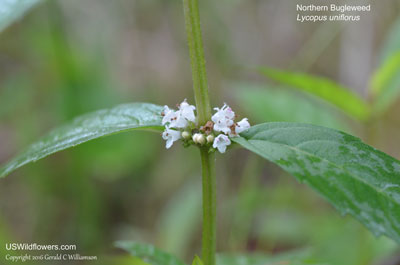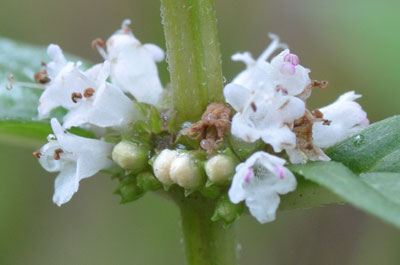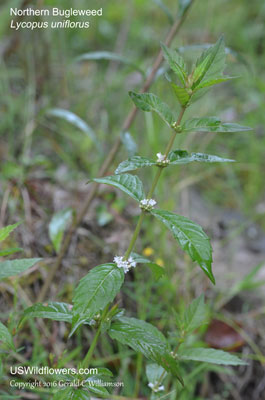Northern Bugleweed, Northern Water Horehound - Lycopus uniflorus
|
Lycopus uniflorus - Northern Bugleweed, Northern Water Horehound.
Lycopus is a small genus of about 14 species native to Australia, Eurasia, and also North America which is native to 10 of those species. (One of them, Lycopus laurentianus, is not found in the United States, but rather in the St. Lawrence basin of Canada.) One Eurasian species, L. europaeus, has naturalized in Canada and the eastern United States, probably brought over in the 18th century by settlers who used it for medicinal purposes. Herbalists continue to use it today. In spite of being in the Mint family and similar in appearance to the Mentha genus, Lycopus has little to no aroma when the leaves are crushed. The plants are commonly called Water Horehound and Bugleweed. The latter name comes from the bugle-like shape of the flowers, unusual for members of the Mint family. The former name results from its affinity for wet locations, with Horehound coming from words for "downy" (hoary) and "hune", an old English word for a type of plant. The Bugleweed common name is also applied to members of the Ajuga genus, which is also used herbally, so be careful to are getting what you think if you are seeking herbal remedies.
Lycopus uniflorus is indeed a plant of wet areas - the one on this page was photographed in a high mountain seepage swamp in western Virginia. Its range spreads from coast to coast in the United States and Canada, excluding the southern tier of states. It is rare in several states, including California, Wyoming, Colorado, Kansas, Arkansas, Tennessee, and in the Great Smoky Mountains National Park. Its normal bloom time is June to November.
Found in:
AK, AR, CA, CO, CT, DC, DE, IA, ID, IL, IN, KS, KY, MA, MD, ME, MI, MN, MO, MT, NC, ND, NE, NH, NJ, NY, OH, OK, OR, PA, RI, SC, SD, TN, VA, VT, WA, WI, WV, WY, GS | 
Distribution of Lycopus uniflorus in the United States and Canada:

Blue=Native; Grey=Introduced
Map from USDA Plants Database:
USDA, NRCS. 2017. The PLANTS Database (http://plants.usda.gov, 08 May 2025). National Plant Data Team, Greensboro, NC 27401-4901 USA.
Search Our Database: Enter any portion of the Scientific, Common Name, or both.
Do a general Google search of the entire site:
#ad
 Follow USWildflowers on Twitter
| | Site: Grayson Highlands State Park, Grayson County, VA Date: 2016-August-03 | Photographer: Gerald C. Williamson
Nikon D7000
Tamron SP 90MM f/2.8 AF Macro | | The white flowers of Lycopus are unusual for Lamiaceae - they are radially symmetric (actinomorphic) rather than bilaterally symmetric (zygomorphic), giving them a bugle shape leading to the Bugleweed common name. Lycopus uniflorus is somewhat unusual for the genus in that the corolla usually has 5 lobes rather than the more normal 4 lobes of most species. The plants in this genus have bifid stigmas, seen on several flowers in this photo. They also have two exserted fertile stamens, another rudimentary, sterile pair may be present. | | 
| | Site: Grayson Highlands State Park, Grayson County, VA Date: 2016-August-03 | Photographer: Gerald C Williamson
Nikon D7000 | | The inflorescence of all members of Lycopus are axillary verticillasters - they appear to be whorls of flowers around the stem, but are really two opposing, axillary clusters. The leaves of Lycopus uniflorus are sessile or nearly so; other members of the genus may have clasping leaves or longer petioles. | | Click on the photo for a larger image

| | Site: Grayson Highlands State Park, Grayson County, VA Date: 2018-August-03 | Photographer: Gerald C Williamson
Nikon D7000 | | Lycopus flowers have a hairy throat, seen in a couple of the flowers in this photo. Among the identifying attributes for Lycopus species is the shape of the calyx teeth. Lycopus uniflorus is among those with acute tips, but notably shorter than the corolla tube. Others have acuminate (long-pointed) or subulate (needle-like) tips which extend further up the corolla tube. Most keys use the length of the calyx teeth relative to the nutlets (seeds) if you find them in seed - note whether the teeth are longer or shorter than the nutlets. | | Click on the photo for a larger image

| | Site: Grayson Highlands State Park, Grayson County, VA Date: 2016-August-03 | Photographer: Gerald C Williamson
Nikon D7000 | | Lycopus uniflorus can grow to a little over 3 feet tall. It has opposing, lanceolate to oblong leaves with a serrate or toothed margin with 4 to 7 teeth per side, most usually 5 in the lower and middle leaves. | | Click on the photo for a larger image

|
References used for identification and information:
|
|
| |
| #ad
|
|






